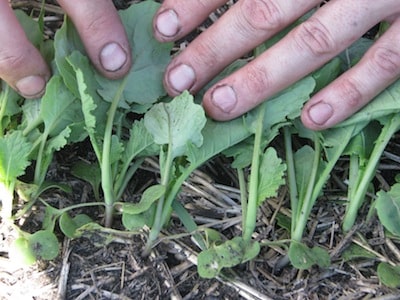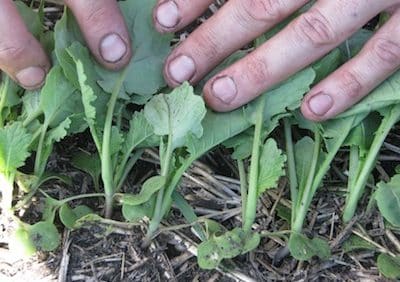In early to mid May, when seeding is in full swing and conditions are good, growers can slow down and take their time. Canola growers have four good economic reasons to do so:
1. Consistent canola seed placement at a uniform depth improves seed survival and the return on seed investment. Targeting 5 to 8 plants per square foot gives the crop a better chance to meet its yield potential.
2. A crop with quicker canopy closure can eliminate the need for a second in-crop herbicide application.
3. A stand at the higher end of the recommended 5 to 8 plants per square foot leaves growers a little leeway when it comes to disease and insect management decisions, knowing that losing a plant or two per square foot will not reduce yield potential.
4. A uniform plant stand of 5 to 8 plants per square foot could mature a little faster than a thinner stand, which will branch out more. The more branches, the longer it takes for all seeds to mature.
With its seed cost feature, the Canola Calculator can help canola growers set seeding rates that balance agronomy and economics.

Keep the following in mind when seeding canola:
Deeper = deadlier. Half an inch to one inch below the packer furrow is the recommended seed depth for canola. This will reduce days to emergence and reduce the seed energy required for emergence. This also reduces the number of weeds that are able to emerge ahead of the crop.
Consistent = cash. The more consistent the better. For some drills, the overall average may be one inch, but the range could be 0”-2”. Too shallow or too deep both contribute to seed and seedling mortality, and those that do emerge from too shallow or too deep will have highly variable emergence dates, creating an uneven field.
Faster = F’d. The ideal speed will vary by drill and soil conditions. In general, at higher speeds, rear openers tend to throw more soil over the front rows. Seed in these front rows will be buried deeper, making them slower to emerge — if they emerge at all. Re-check depth when moving from one field to the next.
Penetrate trash. Spread residue evenly in the fall, and have a drill that can penetrate trash so all openers place seed into the soil.
Firm the bed. Openers that fracture the seedbed to place fertilizer lower than the seed may not provide the firm moist seedbed that canola needs. Worn openers that do not provide a defined seed ledge and high fan speeds that cause seed bounce can also reduce an opener’s ability to place seed precisely.
Not too many bedfellows. Seed-placed fertilizer can damage canola seedlings. There can be safe low rates of seed-placed nitrogen in some cases, but the best practice is to save the spot in the seedrow for 20-25 lb./ac. of phosphate and put other nutrients away from the seed row. Try SDSU’s Seed-Placed Fertilizer Decision Aid
Pack appropriately, if drill adjustments are possible. In dry conditions, pack more to conserve moisture in the seed row. In wet conditions, reduce packing pressure to limit hard crusting. Packing pressure can be a delicate balance, and often changes by soil type as well as moisture conditions.
Be patient. Taking time to seed right provides the four known benefits at the top. It also lowers the risk that a field will need to be reseeded. Canola seeded a second time adds to input costs (for seed) and lowers quality and yield potential, given the later seeding date. Another logistical reason to be patient: If all canola is seeded the same week, it could mean a tight harvest window if everything matures at the same time.
Further reading:
Get the drill ready for spring
Alberta data shows seeding date and yield correlation

